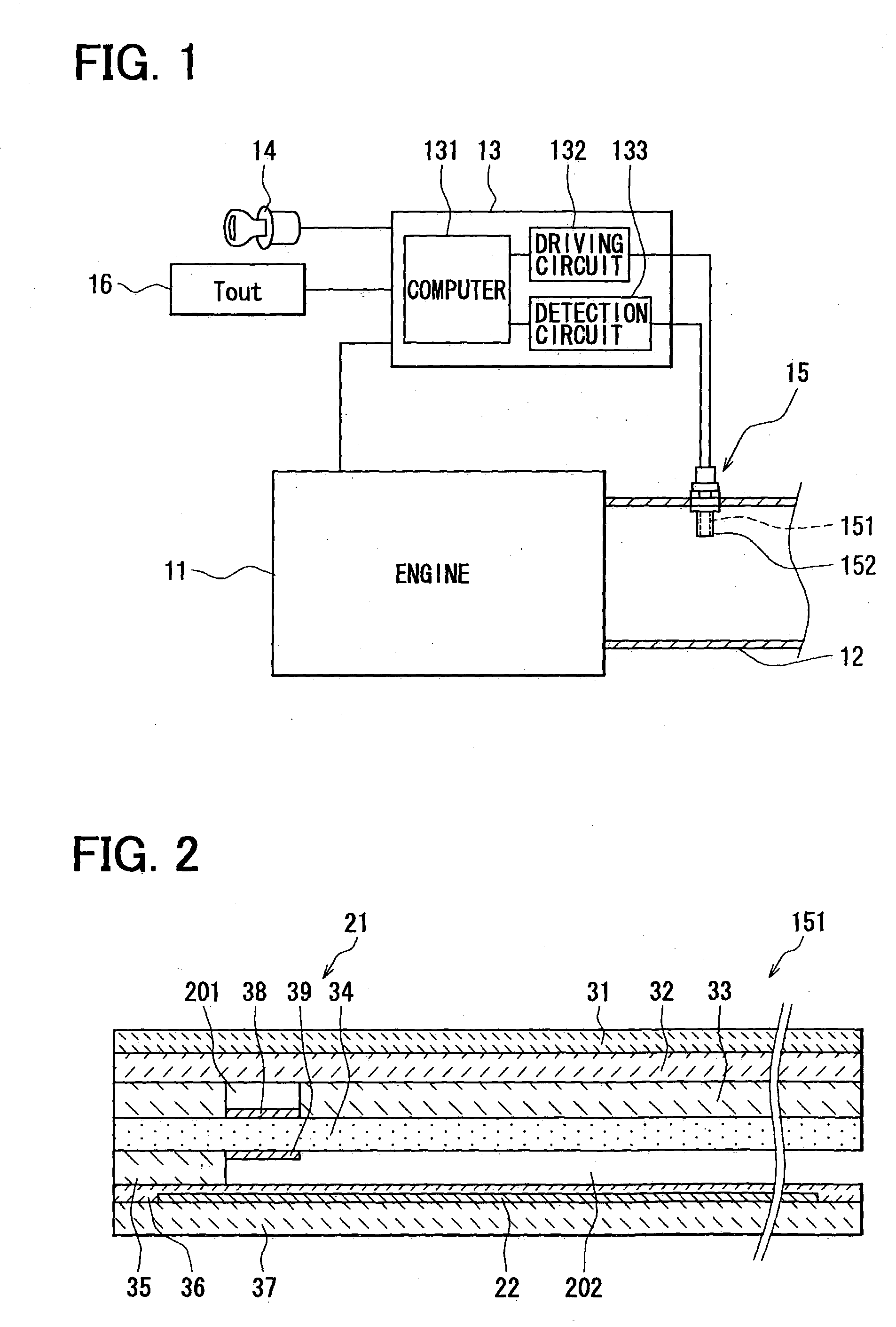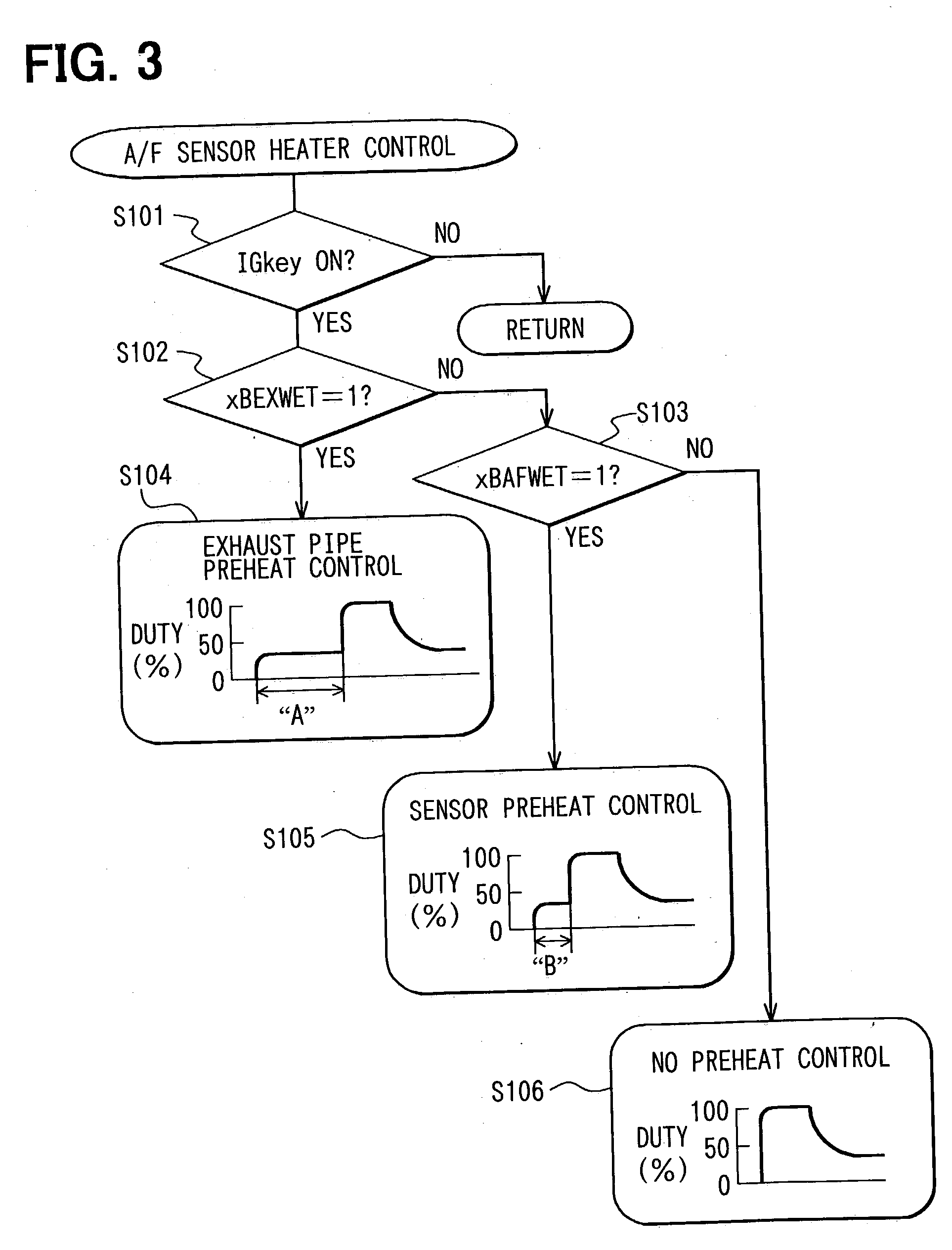Heating control system for gas sensor of engine
a technology of heat control system and gas sensor, which is applied in the direction of electrical control, instruments, material electrochemical variables, etc., can solve the problems of zirconia or the like, gas sensor damage, and fragile nature of gas sensor
- Summary
- Abstract
- Description
- Claims
- Application Information
AI Technical Summary
Benefits of technology
Problems solved by technology
Method used
Image
Examples
first embodiment
[0025] (First Embodiment)
[0026] Referring to FIG. 1, an internal combustion engine having a heating control system of a gas sensor according to the first embodiment is illustrated. The first embodiment is applied to an automobile, for instance. An engine main body 11 of the internal combustion engine has a common structure. The engine main body 11 generates motive energy by combusting fuel and discharges exhaust gas to an exhaust pipe 12.
[0027] Various parts of the engine main body 11 are controlled by an electronic control unit (ECU) 13. The ECU 13 has a basic structure used in the common internal combustion engine. The ECU 13 starts the engine main body 11 if an ignition key 14 is switched on and controls torque or rotation speed based on information such as a throttle opening degree.
[0028] Various sensors provide information on operating conditions, which is used in the control performed by the ECU 13. As one of the sensors outputting detection signals to the ECU 13, an air fuel ...
second embodiment
[0062] (Second Embodiment)
[0063] Next, control of the energization to the heater 22 of the A / F sensor 151 performed by an ECU 13 according to the second embodiment will be explained based on a flowchart shown in FIG. 6.
[0064] The control performed by the ECU 13 according to the second embodiment is generally similar to that of the first embodiment. However, in the energization control according to the second embodiment, the duty ratio of the driving current applied to the heater 22 of the A / F sensor 151 is set in a method different from that of the control according to the first embodiment. The processing flow for setting the duty ratio is shown in the flowchart in FIG. 6. The processing shown in FIG. 6 is started when the engine is started, or when the ignition key 14 is switched on.
[0065] In Step S401, the ambient temperature T.sub.out is inputted. Then, in Step S402, it is determined whether the water is adhering to the exhaust pipe 12 based on the determination flag xBEXWET. If ...
third embodiment
[0074] (Third Embodiment)
[0075] Next, energization control of the heater 22 of the gas sensor 151 performed by an ECU 13 according to the third embodiment will be explained based on a flowchart shown in FIG. 8.
[0076] The control performed by the ECU 13 according to the third embodiment is generally similar to that of the first embodiment. However, in the energization control performed by the ECU 13 of the third embodiment, a duty ratio of the driving current applied to the heater 22 of the A / F sensor 151 is set in a method different from that of the first embodiment.
[0077] First, in Step S501, resistance RI between the electrodes 38, 39 of the pump cell 21 of the A / F sensor 151, or element resistance RI, is detected. The element resistance RI correlates with temperature T.sub.e of the A / F sensor 151 as shown in FIG. 9. Therefore, the element resistance RI is employed as a parameter of the temperature T.sub.e of the A / F sensor 151. More specifically, a general method to calculate the...
PUM
| Property | Measurement | Unit |
|---|---|---|
| boiling point | aaaaa | aaaaa |
| temperature | aaaaa | aaaaa |
| temperature | aaaaa | aaaaa |
Abstract
Description
Claims
Application Information
 Login to View More
Login to View More - R&D
- Intellectual Property
- Life Sciences
- Materials
- Tech Scout
- Unparalleled Data Quality
- Higher Quality Content
- 60% Fewer Hallucinations
Browse by: Latest US Patents, China's latest patents, Technical Efficacy Thesaurus, Application Domain, Technology Topic, Popular Technical Reports.
© 2025 PatSnap. All rights reserved.Legal|Privacy policy|Modern Slavery Act Transparency Statement|Sitemap|About US| Contact US: help@patsnap.com



